New Year’s Traditions From Around The World
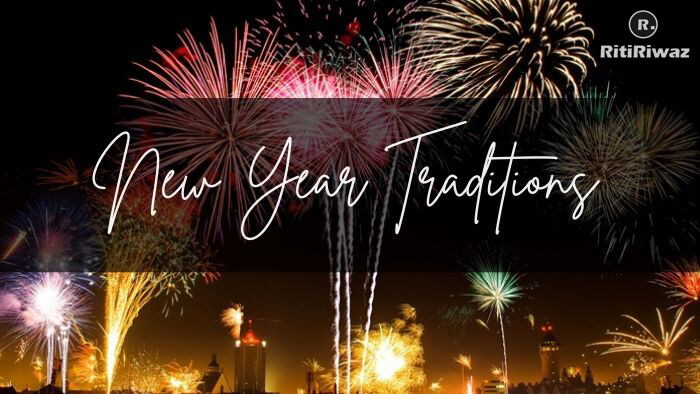
New Year is considered the new beginning of a lot of things and is one of the most popular public holidays of the year. On the midnight of 31st December and on 1st January there is a celebration of New Year all over the world. Different countries have different New Year’s traditions for this holiday, whether it is a family party, grabbing drinks, play with fire, or smashing plates. New Year traditions of a country reflect their cultural heritage of the Country.
Each country seems to have its own unique New Year celebrations, with different customs for ensuring health, wealth, happiness, and luck in the coming year. To celebrate the ringing of New Year, we are sharing some unique traditions of some countries.
Denmark

Denmark has the tradition of smashing plates on your neighbor’s houses. These plates are thrown after midnight for good luck and whoever has the largest pile in the morning is said to have the most loyal friends.
Spain
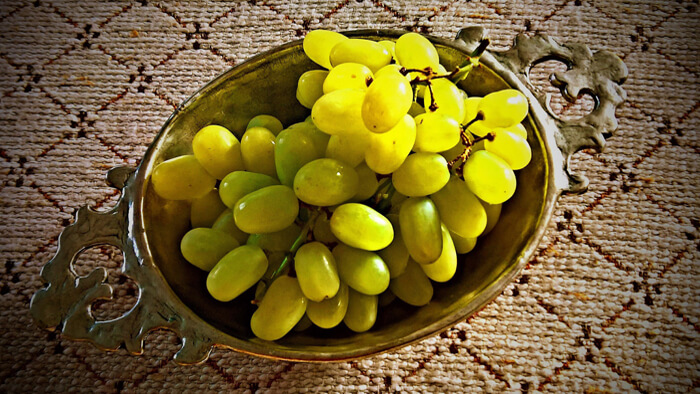
New Year’s Eve in Spain is known as Noche Vieja (Old Night). It is a custom to stay at home till midnight and at midnight people eat doce uvas (twelve grapes), one at each stroke of the clock. This is supposed to bring good luck, prosperity, and happiness to el Año Nuevo (the New Year). This tradition also practiced in other countries like Mexico, started in the 19th century, and was believed to ward off evil. Eating the 12 grapes is said to bring you prosperity and good luck in the new year. Then they dance the night until the early hours in the morning.
France
December 31st – New Year’s Eve is called la Saint-Sylvestre and is celebrated with a feast by most people, called le Réveillon de Saint-Sylvestre unsurprisingly (31 December is his saint’s day). The feast includes special items like champagne and perhaps controversially foie gras, the accompanying party can range from an intimate dinner with friends to lavish public events most often called une soirée dansante (a dance ball). At midnight, everyone kisses under the mistletoe and offers their best wishes for the new year.
Mexico
New Year’s Eve in Mexico is called Nochevieja and celebrated on December 31st. Mexicans gather together with their loved ones to welcome in the upcoming year. Family and friends get together for this occasion and as a tradition, they prepare many things – from food to what they wear – on New Year’s Eve to guarantee good fortune, luck, good health, and more for the coming year.
Mexico as well as in some other countries in Latin America involves making a type of scarecrow or dummy out of old clothes stuffed with newspaper or other material. You may find them sitting on street corners or rooftops in the last few days of the year. These represent “el año Viejo” (the old year) and are lit on fire at midnight along with some firecrackers, signifying leaving behind the failures and regrets in the past year to welcome the one to come. Mexicans also believe that eating twelve grapes as the clock strikes midnight on the 31st December will bring good luck and each grape grants you a wish for the new year.
Ecuador
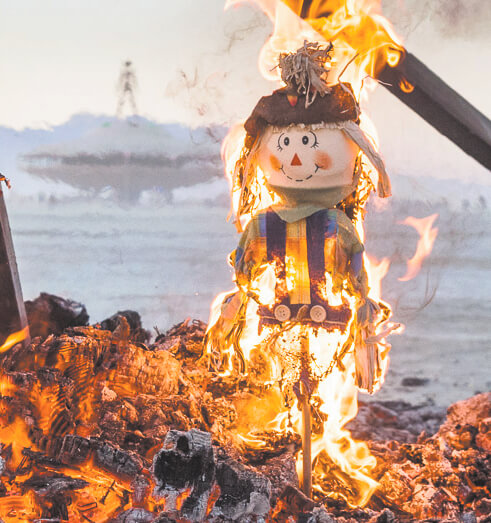
At midnight on New Year’s Eve, people in Ecuador burn effigies representing the old year, or at least the bad stuff from it. These effigies or Monigotes, dolls vary from simple scarecrow-type figures to huge and elaborate portrayals of famous pop culture characters, politicians, and other individuals associated with the year that just ended.
By burning a doll that represents the old year, people feel as though they are starting the new year with a clean slate. It is no surprise to see streets blocked by men dressed as women, which represent it’s the widow of the ending year, begging for any coin, their interpretation may include dancing and flirting with car drivers. This symbolizes getting rid of all the bad of the old year. People then jump over the fire of the burning doll for good luck.
Uruguay
While many South Americans have the tradition of throwing a pan or glass of water out of the window to rid themselves of the bad luck of the past year, Uruguayans take it to the next level with the Guerra de Sidra (The Cider War Festival) in Montevideo. During this time, anyone who visits the Port Market is fair game as cider, beer, and water fights break out.
Peru
In Peru, you can predict your financial situation for the upcoming year with potatoes. Take one fully-peeled, one half-peeled, and one unpeeled potato, and throw them under the bed. Then without looking, grab the first potato you encounter. If you chose the unpeeled potato, you will have good fortune in the year to come. If you chose the half-peeled potato you will have a normal year, and if you were unfortunate enough to pick the fully-peeled potato, you will have financial trouble.
Colombia
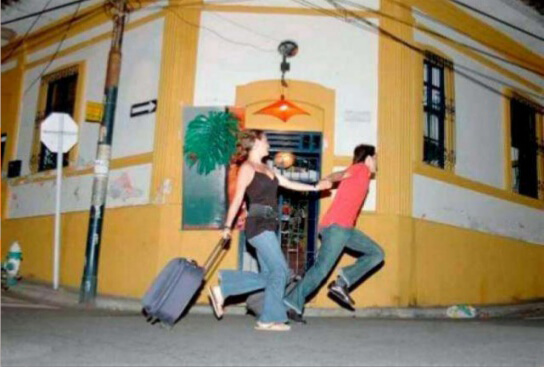
Colombia has a wide array of superstitions, such as standing at midnight to ensure money, luck, and health; slamming the door to ward off evil spirits from the home; eating the twelve grapes; and taking a packed suitcase around the block in order to travel during the upcoming year.
Wearing yellow is one of the most popular New Year’s Eve rituals because it brings good luck, and just like Peruvians and Ecuadorians, Colombians also make dolls that are then burned. One of the differences is that in Colombia they are stuffed with fireworks and placed along the road to welcome the New Year with colorful sparks that fill the night sky.
Many Colombians will take an empty suitcase and run around their block as fast as they can. Legend says if you’re in good spirits and do this the right way (perhaps without tripping?), your next lap around the sun will guarantee at least one traveling adventure.
Finland
In Finland we celebrate this in many ways, which most are the same as around the world; fireworks, eating well, having a party, etc. But Finland has a quite unique tradition which dates from the early 19th century which is the casting of tin.
The casting is usually done during New Year’s Eve before midnight. We use a small scoop made out of metal and place it on an electric stove. Then we place the horseshoe-shaped tin in the scoop and let it melt. After it has melted, the scoop is emptied quickly into a bucket filled with water.
The secret is that the pouring should be done quickly so it will become a single piece of tin. If the melted metal is not poured continuously it will create several different pieces and that, by old tradition, means bad luck. The metal cools instantly when in the cold water and forms different kind of shapes.
Romania

Romanian New Year traditions are the mask-dances when people dress up as bears, horses, goats, or other fictional characters like the devil, which is believed to ward off evil spirits. It is a magical ceremony of death and rebirth, of endings and new beginnings. Many people in Romania believe that if you toss a coin in the river, you will have good luck all year. It is recommended that at the stroke of midnight your wine glass is full, you have money in your pocket and you wear something red.
Nigeria
Nigeria people travel back to villages to see their older folks, and those in villages come to cities to see their brothers and sisters and to enjoy the season in the city. People also buy new clothes or sew new ones to reflect a new appearance; while individual homes and streets get decorated with ribbons and lighted Christmas trees and all sorts of colorful lights.
During New Year celebrations, youths fire firecrackers or “bangers” in the spirit of celebrations, and many youths in several regions organize carnival parties that last all day and night long. The carnivals take the form of street parades and color processions to parties and music and orgies – starting from New Year Eve till daybreak.
Philippines
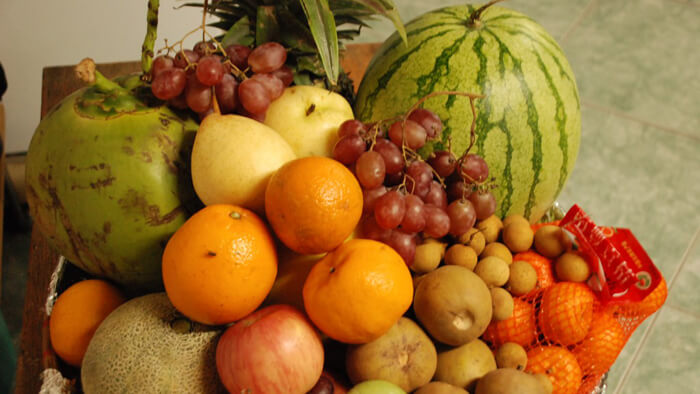
In the Philippines, one way to celebrate the coming year is with a fruit bowl. There is preparation or display of 12 different round fruits at the dining table on New Year’s Eve to wish everyone prosperity for the new year ahead! The round fruits symbolize wealth, just like the shape of coins and the 12 fruits correspond to each month of the year. The 12 fruits are then eaten in the following few days.
Ukraine
In Ukraine, they love to celebrate so much, that we’ve even made sure we have two New Year’s Eves. The first one follows the Gregorian calendar and falls on January 1st when we join in with the rest of the world in the craziness of fireworks and midnight parties. The second one follows the Julian calendar and falls on January 14th, leaving us plenty of time to rest after the all-night dancing of the first New Year’s Eve and… do it all over again.
Italy
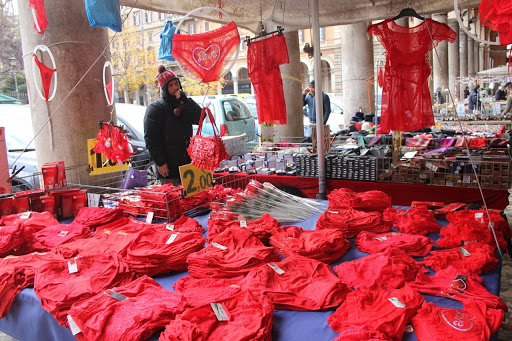
In Italy there is a tradition that goes back even to the Romans: on December 31st, everyone must wear something red. Whether it’s the underwear, a shirt, or just a detail like a hair clip, everyone must have something red. This color has strong symbolic power, as it represents power, fertility, health, and wealth. The night between December 31st and January 1st, they eat, chat, and play, waiting for midnight. And at the stroke of midnight, they exchange wishes, and drink a good glass of sparkling wine, to continue celebrating.
Greece
Greece follows a weird tradition to welcome New Year, card and dice games are played at home as well as in the casinos and it is believed that this will bring happiness on the winner’s end.
China
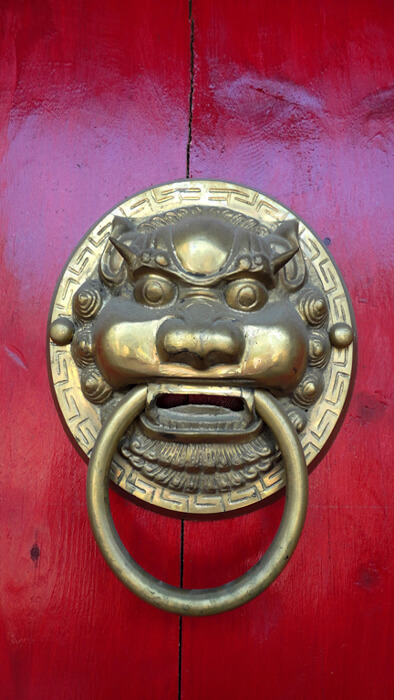
To symbolize happiness and good luck in the New Year, Chinese celebrants paint their front doors red. In general, red colors are New Year’s Eve in China, with red packets of money for children, red rackets for married couples, and red lanterns.
Japan
Japan follows Buddhist beliefs and people used to ring bells 108 times, based on the belief that it brings cleanness. It is also believed that smiling and going into the New Year happily will bring good luck.
United States Of America
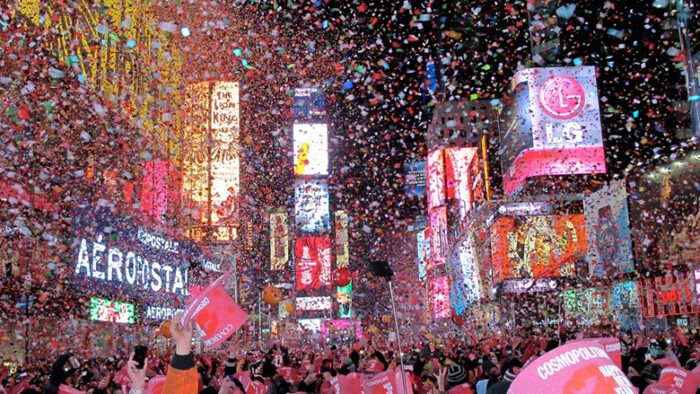
Americans in the South eat black-eyed peas on New Year’s Day for good luck. They believe that by consuming these black-eyed peas, the upcoming year will bring fortune for them.
Egypt
In Egypt, like other Arab and Islamic countries, we celebrate the New Year as the birthday of the prophet “Muhammad”, as he was born on the 12th of Rabie 1st (according to Arabic months) more than 1464 years ago. Other traditions of the season include the making of New Year’s resolutions.
Traditionally, it was thought that one could affect the luck they would have throughout the coming year by what they did or eat on the first day of the year. For that reason, it has become common for folks to celebrate the first few minutes of a brand new year in the company of family and friends. Parties often last into the middle of the night after the ringing in of a new year.
Greece
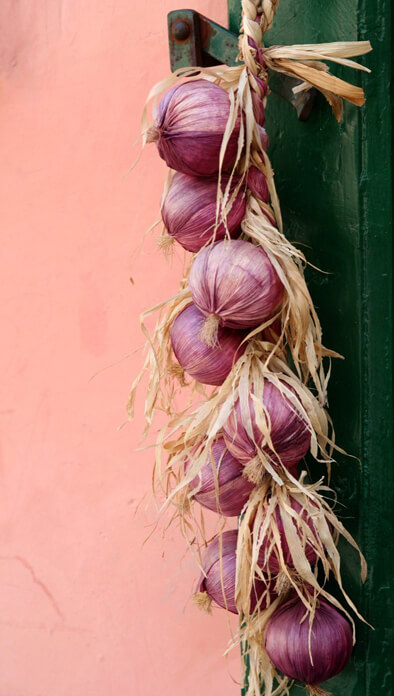
In Greece, people associate onions with rebirth and development, so they hang them on their doors to make sure they continue to grow in the new year.
Russia
Originally, Russian New Year was celebrated on the 1st September, but in 1918 this all changed as the calendar was altered to align with western European celebrations on January 1st. Across the country, many people welcome the New Year twice! On January 14th, comes the “The Old New Year”, which marks the start of the year in the Russian Orthodox Calendar. There is a tradition of putting New Year tree and under the tree, you place two figures of Grandfather Frost and his granddaughter.
It is a bad omen to sleep through the New Year’s — then the year will be “sleepy” and uneventful. Young people tend to have dinner with their parents before going out to party with their friends after midnight. It’s also believed that to honor the new year, it’s best to wear new clothes or at least new underwear.
Brazil
In Brazil is a tradition on December 31 to go to the beach watch fireworks, in white clothes, and holding white roses to throw on the sea in homage to Iemanjá (deity of Afro-Brazilian religion Candomblé). On the beach, people often build small boats filled with gifts for the goddess of the ocean, Yemanja.
And also is common to jump surf seven times and make a wish for the new year. They also wear brand new underwear (bought for the occasion) of a specific color, depending on what they hope from the new year: yellow symbolizing gold, will bring money, red or pink will bring love, green will bring hope and blue will bring health.
South Africa
South Africa for New Year’s Eve is not confetti that’s sprinkled from the skies, but, the furniture that catapults to the ground below. Though this is not a widely adopted practice throughout the land, certain areas believe the physical act of tossing unused goods from their window sends a signal to the universe that you have let go of past grievances and are hopeful for the future.
Scotland
In Scotland New Year’s Eve or Hogmanay, as they call the last day of the year, is a bigger deal than Christmas. The massive party goes on for days and incorporates age-old acts, such as first-footing. It’s considered good luck to have a tall, dark man enter the home for the first time after midnight.
Ireland
In Ireland, single women hoping to find love in the new year traditionally sleep with mistletoe under their pillow on New Year’s Eve.
Turkey
In Turkey, some people sprinkle salt on their doorstep at midnight to bring them peace and prosperity. Others open pomegranates to attract wealth.
Suggested Read: Countries that do not celebrate New Year on 1st January
New Year 2024: Wishes, Quotes, Messages, Facebook post & Whatsapp status
